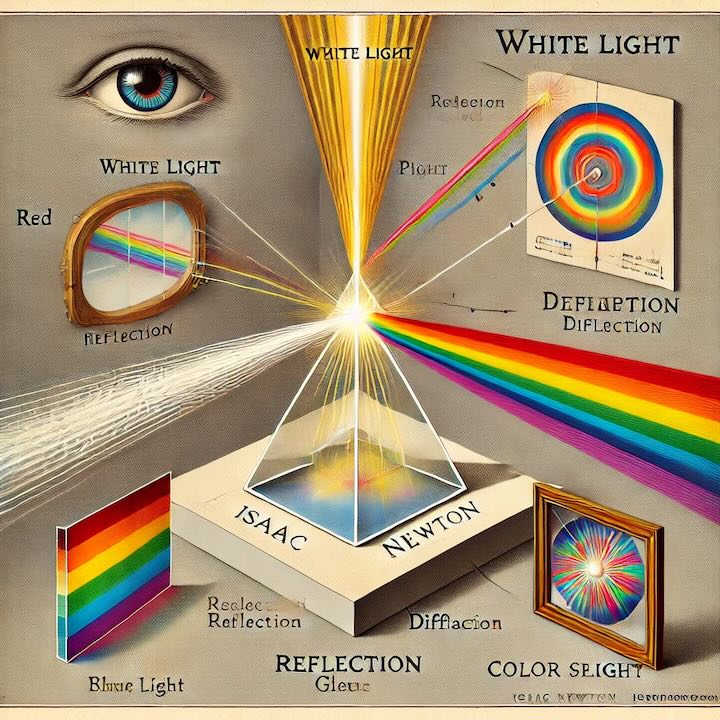
In 1704 Isaac Newton published his work "Optick". This was the result of Newton's work on reflection, refraction, diffraction and the spectra of light.
Isaac Newton’s “Opticks,” published in 1704, is one of the most influential works in the history of science, particularly in the field of optics and the study of light. Unlike his more famous “Philosophiæ Naturalis Principia Mathematica,” which dealt primarily with physics and mathematics, “Opticks” focused on the properties of light and color. It was groundbreaking in its experimental approach, representing Newton’s shift toward an empirical understanding of natural phenomena.
Newton’s “Opticks” emerged from decades of his own research into the nature of light and its behavior. His interest in the subject began in the 1660s when he conducted a series of experiments that would eventually become known as his experiments with prisms. These experiments allowed him to make critical observations about how light refracts, or bends, when passing through a prism. Newton’s experiments demonstrated that white light is not pure but rather composed of a spectrum of colors—red, orange, yellow, green, blue, indigo, and violet. This was a significant discovery because, before Newton, many scientists, including prominent figures like René Descartes, believed that light was a uniform entity and that colors were the result of modifying white light, rather than being intrinsic components of it.
In “Opticks,” Newton systematically presented his theories and experiments on light, reflection, refraction, diffraction, and the nature of color. One of his central points was that light behaves as particles or “corpuscles” rather than as waves, as others like Christiaan Huygens had proposed. Newton’s particle theory of light suggested that light consists of small particles emitted in straight lines from a source, such as the sun. When these particles encountered an object, they would reflect or refract according to precise, predictable laws, similar to the motion of solid objects in physics.
Newton divided his work into a series of “Queries” at the end of “Opticks.” These queries were speculative questions about the nature of light, color, and even matter itself. While some were simply questions posed to stimulate thought and discussion, others offered hypotheses that Newton was not fully prepared to prove. For example, one query touched on the idea of “action at a distance”—a concept that would later play a crucial role in his work on gravitation.
The first sections of “Opticks” dealt extensively with reflection and refraction. Newton’s law of refraction was based on a mathematical description that allowed him to predict how light would behave when it passed through different media. He explained how light bends when it moves from one medium to another—like from air into glass—and provided detailed equations to describe this bending, now commonly referred to as Snell’s Law. Newton’s work on diffraction, which he referred to as “inflection,” examined how light bends slightly when it passes near the edges of objects. This led him to develop further insights into the wave-like properties of light, even though he primarily maintained his particle theory.
One of the most enduring contributions of “Opticks” was Newton’s work on the color spectrum. He demonstrated that when light passes through a prism, it is split into its component colors, but when these colors are passed through a second prism, they recombine into white light. This was a conclusive experiment that settled debates about whether colors were inherent in light or merely the result of some distortion. Newton’s findings laid the foundation for the modern understanding of color and are still relevant in the study of light today.
In conclusion, Isaac Newton’s “Opticks” was a masterful work that reshaped the understanding of light and color. It provided the experimental foundation for optics as a scientific field and challenged the prevailing wave theories of light, offering a new corpuscular theory. Though some of Newton’s hypotheses about light as particles would later be modified by quantum physics and wave-particle duality, his pioneering experiments and observations have had a lasting impact. His meticulous experimentation, combined with theoretical brilliance, made “Opticks” a cornerstone of scientific thought and an essential contribution to the scientific revolution.
 >
>